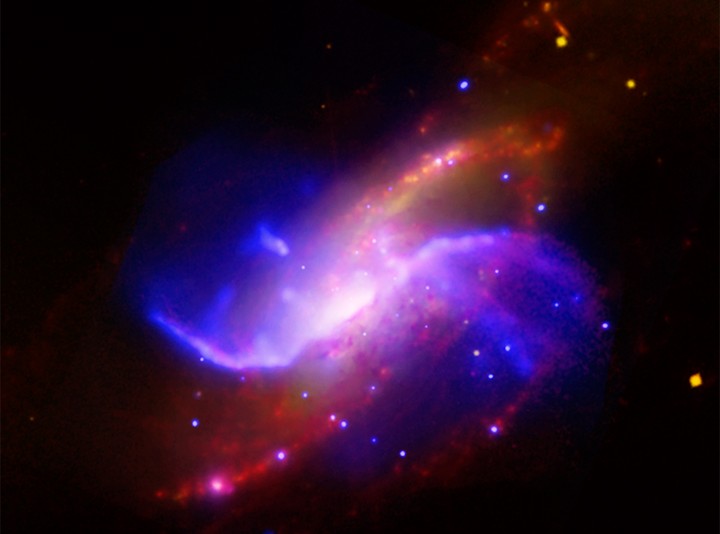Credit & Copyright: X-ray:
Andrew Wilson (UMCP)
et al.,
NASA,
CXC
Optical: DSS / IR: NASA, JPL-Caltech / Radio: NRAO, AUI, NSF
Explanation:
Better known as M106, bright
spiral galaxy
NGC 4258 is about 30 thousand light years across and
21 million light years away
toward the northern constellation
Canes Venatici.
The yellow and red hues in
this composite
image show the
galaxy's sweeping
spiral arms
as seen in visible and
infrared light.
But x-ray
and
radio data
(blue and purple) reveal two extra
spiral arms -- arms that don't align with the more familiar tracers
of stars, gas, and dust.
In fact,
an analysis
of the x-ray and radio data suggests
that the anamolous arms are composed of material heated
by shock waves.
Detected at radio wavelengths,
powerful jets originating in the
galaxy's core likely drive the shocks into the disk
of NGC 4258.
Optical: DSS / IR: NASA, JPL-Caltech / Radio: NRAO, AUI, NSF
1999 2000 2001 2002 2003 2004 2005 2006 2007 2008 2009 2010 2011 2012 2013 2014 2015 2016 2017 2018 2019 2020 2021 2022 2023 2024 2025 |
Январь Февраль Март Апрель Май Июнь Июль Август Сентябрь Октябрь Ноябрь Декабрь |
NASA Web Site Statements, Warnings, and Disclaimers
NASA Official: Jay Norris. Specific rights apply.
A service of: LHEA at NASA / GSFC
& Michigan Tech. U.
|
Публикации с ключевыми словами:
M 106 - spiral galaxy - spiral arms - radio - спиральная галактика - Спиральные ветви галактик - рентгеновское излучение - Радиоизлучение
Публикации со словами: M 106 - spiral galaxy - spiral arms - radio - спиральная галактика - Спиральные ветви галактик - рентгеновское излучение - Радиоизлучение | |
См. также:
Все публикации на ту же тему >> | |
